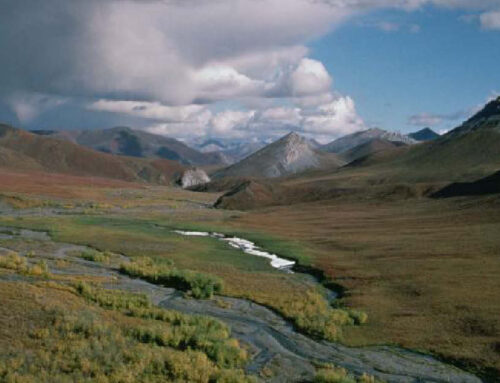View/Download this article in PDF format.
The Bureau of Land Management (BLM) administers mineral leasing on 245 million acres of public lands, including onshore federal oil and gas leasing. The BLM recently proposed a new rule to limit the practice of venting and flaring natural gas from oil and gas wells on federal lands.[1] It replaces a 35-year-old rule that has led to the loss of billions of dollars’ worth of federal gas. The new rule will reduce the amount of gas that is lost and increase returns to the taxpayer and industry by increasing the capture and sale of natural gas. Federal onshore oil and gas minerals are a public trust resource, and preventing waste of these resources will encourage more responsible use.
Ineffective, Outdated Rule
Venting, flaring, and royalty-free uses of oil and natural gas on BLM-administered leases have been governed by the Notice to Lessees and Operators of Onshore Federal and Indian Oil and Gas Leases, Royalty or 
Before the finalization of the new rule, no other federal rule covered all potential sources of lost gas. While some states have policies in place to reduce waste of natural gas, no state has established a comprehensive set of requirements addressing all three avenues for waste—flaring, venting, and leaks—and only a few states have significant requirements in even one of these areas.
NTL-4A has failed to effectively limit waste on oil and gas production. From 2009 through 2013, increases in the amount of gas lost from federal oil leases outpaced increases in oil production in some states.[3] Overall, venting and flaring of natural gas on federal leases has more than doubled in the last decade.
A principal reason current rules have failed is that they depend on subjective judgments made by a BLM Supervisor or Authorized Officer about what constitutes “waste.”[4] There has been considerable ambiguity regarding what properly constitutes royalty-free, on-site use, and not surprisingly, there has been “substantial variation in how the BLM has interpreted and applied the standard” for approval of flaring.[5]
The Government Accountability Office (GAO) has found significant dysfunction in the Department of the Interior’s (DOI’s) accounting for lost gas. The GAO concluded that the DOI “may not have a clear accounting of natural gas emissions, which could limit [DOI’s] ability to ensure that lessees pay royalties in the proper amounts and minimize waste of natural gas.”[6] The GAO estimated that 90 percent of the 1,281 requests received by BLM field offices in fiscal year 2014 did not contain the appropriate documentation, yet the BLM approved 70 percent of those requests anyway.[7]
Correcting Problems
NTL-4A has not been effective at reducing waste of natural gas. BLM’s new waste reduction rule will remedy many of the well-documented problems. It will curb waste of natural gas and help ensure a fair return on public resources for federal taxpayers. Some features of the new rule are as follows:
- Charges a royalty on gas that is flared from wells that are connected to capture infrastructure.
According to TCS analysis of data from the Office of Natural Resource Revenue, roughly 90 percent of the gas vented or flared over the last decade was royalty-free. Charging a royalty for loss of associated
TCS Report on Methane Waste on Federal Lands |
 |
gas will create incentives to capture and sell this gas, which will reduce waste and increase revenues. The new rule also clarifies when to charge royalties for lost gas, as vague standards of the old rule resulted in inconsistent application of BLM standards.
- Creates targets for capture of lost gas, to be phased in from 85% in 2018 to 98% in 2026.
Old rules included no upper boundary for flaring. According to industry reported data, wells in some states flared and vented more gas than they sold. BLM’s responsibility is to direct where and when development occurs on federal lands in order to maximize recovery of energy resources and ensure a fair return to taxpayers. This new limit will help encourage responsible development.
- Prohibits venting, except for emergencies and venting from certain equipment subject to proposed limits. Replaces all “high bleed” pneumatic controllers with “low bleed” controllers within one year.
One of the largest sources of leaked natural gas has been from unintentional loss through equipment (rather than intentional venting). Oil and gas operators on federal lands are allowed to consume gas on the lease site to power their equipment, free of charge. Again, because there is no incentive to replace aging equipment, large quantities of gas are leaked during operation.
- Requires use of an instrument-based leak detection and repair (LDAR) program to find and repair leaks twice a year.
Similar to requirements to replace old, leaky equipment, the LDAR requirements will allow the BLM to collect data on leaked gas in order to prevent further leakage. Until the new rule, the BLM did not have any system in place to collect information about gas from BLM-administered leases that was being leaked.
- Allows royalty rates to be increased in the future for new competitive onshore oil and gas leases, consistent with the Mineral Leasing Act.
Unlike other resource development plans, outdated rules required BLM to conduct a formal rulemaking in order to change the royalty rate charged for new oil and gas leases. This change will allow the BLM to consider other royalty rates to better reflect market conditions.
[1] “Waste Prevention, Production Subject to Royalties, and Resource Conservation” Proposed Rule at 81 FR 6616 (February 8, 2016)
[3] Bureau of Land Management. Regulatory Impact Analysis for: Revisions to 43 CFR 3100 (Onshore Oil and Gas Leasing) and 43 CFR 3600 (Onshore Oil and Gas Operations). January 14, 2016. Document ID: BLM-2016-0001-0002. Page 202.
[5] 81 FR 6640 (February 8, 2016)
[6] Government Accountability Office. GAO-16-607 – “OIL AND GAS: Interior Could Do More to Account for and Manage Natural Gas Emissions.” July 21, 2016.











Get Social